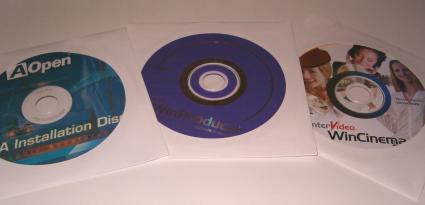2D Quality and Bundle
I don't often talk about 2D quality on modern video cards. Equipped with 350MHz or 400MHz RAMDACs, nearly all modern graphics cards will have peerless 2D analogue output of excellent quality. DVI-I brings digital output to the party for compatible LCD and rare digital CRT displays, offering a further 2D clarity boost.The AOpen, despite having the same RAMDAC setup as the reference board, delivers a quite startling 2D analogue picture. It's measurably sharper than any card I've used recently, the most obvious difference between it and other cards. While that's a qualitative difference at best, since my eyes aren't your eyes, it's definitely the best looking analogue 2D I've had the pleasure of looking at recently. Make of that what you will. I'm not sure whether AOpen have removed a filter stage before display output hits the RAMDAC for conversion, or whether I'm simply seeing things, but it's very very good.
Bundle
While I'm using up a seperate page to talk about 2D quality, I'll fill it up with talk about the card bundle. Being AOpen, it's light on games (there are none), with only 3 CDs in the box.
The installation disk is notable for shipping the Windows 2000/XP 52.14 driver set, the release candidate for the WHQL'd 52.16 ForceWare set that everyone has been talking about recently. Functionally equivalent to the 52.16 set in the testing I did for the reference board review, I nonetheless used 52.16 for testing the Aeolus, however it's a decent driver to get you started. I spotted a full set of recent 2D and 3D drivers for Linux too, along with a 2D (possibly 3D but it looked old, compiled in 2001) driver for good old BeOS. So alternate OS support is taken seriously by AOpen, something that's religiously missed by many other board makers.
Software utilities are limited to a copy of E-Color, an application that helps you setup colour and display profiles for your graphics card and monitor. There looks to be a SmartDoctor-like application for overclocking and card monitoring, but it wasn't functional (or indeed installable) with the card. The single installable utility written by AOpen was a dynamic driver update utility. Testing it out to see if it worked went fine. I installed the supplied 52.14 set, ran the VGA LiveUpdate Wizard and it duly phoned home, grabbed the 52.16's and installed them for me. Pretty cool, saves pissing about and doing it manually. However with all auto-update utilities, be wary of what it does actually install, keeping an eye on it. It can't run unattended though, you have to load it manually. No problems there.
Being a VIVO board, AOpen ship a copy of InterVideo WinProducer. It's a no frills video capture application, utilising the Philips hardware to grab S-Video or composite video from the blue dongle. Something of note is that AOpen leave discrete S-Video and composite video cables out of the box. You're assumed to have your own.
Finally, we have the obligatory DVI to VGA convertor, should you wish to hang a second analogue display from the DVI connected TMDS. NVIDIA's excellent nView 3.0 software, the code that drives their multi-display implementation present on all GeForceFX cards since the 4MX, fully supports the Aeolus. You get full control over all connected displays with no apparent issue. It's a little less fiddly to setup than ATI's equivalent, but there's not much in it. The feature first pioneered by Matrox is arguably done better by NVIDIA and ATI, at least in terms of a twin display setup. Grab yourself a copy of UltraMon if you are into twin display working, it works well with nView 3.0.
Onwards to the system setup.









